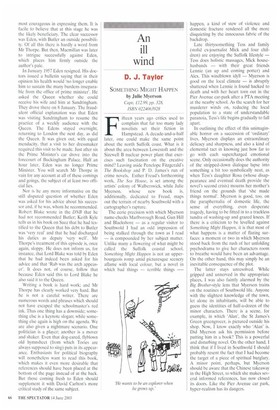An ill wind
D. J. Taylor
SOMETHING MIGHT HAPPEN by Julie Myerson Cape, 172.99, pp. 328, ISBN 0224063928 Fifteen years ago critics used to complain that far too many lady novelists set their fiction in Hampstead. A decade-and-a-half later, one could make the same point about the north Suffolk coast. What is it about the area between Lowestoft and the Sizewell B nuclear power plant that exercises such fascination on the creative mind? Leaving aside Penelope Fitzgerald's The Bookshop and P. D. James's run of crime novels, Esther Freud's forthcoming work, The Sea House, is set among the artists' colony of Walberswick, while Julie Myerson, whose new book is, additionally, dedicated to Freud, maps out the terrain of nearby Southwold with a cartographer's rapture.
The eerie precision with which Myerson name-checks Marlborough Road, Gun Hill and Blackshore — as a regular visitor to Southwold I had an odd impression of being stalked through the town as I read — is compounded by her subject matter. Unlike many a flowering of what might be called the Suffolk coastal school, Something Might Happen is not an upperbourgeois romp amid picturesque scenery aflame with local colour, but a novel in which bad things — terrible things — happen, a kind of stew of violence and domestic fracture rendered all the more disquieting by the innocuous fabric of the backdrop.
Late thirtysomething Tess and family (stolid ex-journalist Mick and four children) are enjoying the Suffolk lifestyle — Tess does holistic massages, Mick househusbands — with their great friends Lennie (an up and coming potter) and Alex. This windblown idyll — Myerson is good on the local climate — is abruptly shattered when Lennie is found hacked to death and with her heart torn out in the Pier Avenue car-park after a PTA meeting at the nearby school. As the search for her murderer winds on, reducing the local population to a state of understandable paranoia, Tess's life begins gradually to fall apart.
In outlining the effect of this unimaginable horror on a succession of 'ordinary' lives, Myerson displays an extraordinary delicacy and sharpness, and also a kind of elemental tact in knowing just how far to go with each supercharged emotional scene. Only occasionally does the authority of the stripped-down dialogue lapse into something a bit too symbolically neat, as when Tess's daughter Rosa (whose disappearance and eventual death provide the novel's second crisis) mourns her mother's friend on the grounds that 'she made things normal'. Myerson is good, too. on the paraphernalia of domestic life, the sense of everything, even desperate tragedy, having to be fitted in to a trackless tundra of washing-up and grazed knees. If there is a criticism to be levelled against Something Might Happen, it is that most of what happens is a matter of flaring surfaces: a moment or two in which Myerson stood back from the rush of her unfolding psychodrama to give her characters room to breathe would have been an advantage. On the other hand, this may simply be an inevitable consequence of the plot.
The latter stays unresolved. While gripped and unnerved in the appropriate places, I was also faintly alarmed by the Big Brother-style lens that Myerson trains on the routines of Southwold life. Anyone with the slightest knowledge of the town, let alone its inhabitants, will be able to guess the identities of half-a-dozen of the minor characters. There is a scene, for example, in which 'Alan', the St James's Green greengrocer, is pictured outside his shop. Now, I know exactly who 'Alan' is. Did Myerson ask his permission before putting him in a book? This is a powerful and disturbing novel. On the other hand, I think that if I lived in Southwold I should probably resent the fact that I had become the target of a piece of spiritual burglary. A minor point, perhaps, but Myerson should be aware that the Chinese takeaway in the High Street, to which she makes several informed references, has now closed its doors. Like the Pier Avenue car park, hyper-realism has its dangers.


































































































 Previous page
Previous page